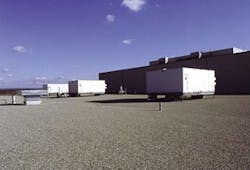Benefits of a cold-applied bitumen roof
When Pratt & Whitney needed a new roof for its 170,000 sq.-ft. aircraft engine-blade manufacturing facility in East Hartford, Conn., company engineers considered three options: single-ply, hot-applied and cold-applied modified bitumen roofing systems. A single-ply system was rejected for durability reasons because the roof required frequent modifications to accommodate ventilation exhausts.
A hot-applied roofing system also was rejected because of odors emitted during installation, says Patrick McCarthy, project engineer, Pratt & Whitney. The plant's 24/7 operations made it impossible to shutdown air intakes to prevent odors from entering the building.
As a result, the company's engineering team of McCarthy, Rajan Anburajan and Bob Vassallo specified a cold-applied, modified bitumen system manufactured by Denver-based John Mansville.
The original roofing system was four-ply cold tar and gravel with cork insulation. After removing the existing roof, installers mechanically fastened 1/2-in. DuraBoard insulation to a 2.5-in. layer of Johns Manville E'NRG'Y2 polyisocyanurate foam insulation. An adhesive heated to 120°F was applied with a spray gun over the insulation. The installers then attached a DynaBase glass reinforced SBS modified bitumen base sheet, followed by a DynaKap modified bitumen cap sheet.
A hot-applied roofing system was rejected at this plant because its 24/7 operations made it impossible to shutdown air intakes during roofing installation.
The abandoned roof openings from the frequent duct moves presented challenges for the roofing contractor, Hartford Roofing Co., Inc. "We had to use a great deal of care in replacing the roof deck at the abandoned openings," says Herb Williamson, vice president, the Hartford Roofing Co., Inc. "We could not let dust or dirt enter the building because of the sensitivity of the manufacturing operation."
Cold-applied roofing adhesive is a relatively new concept, says Lisa Sigler, a Johns Manville Roofing Systems spokesperson. "It's only been in the last few years that cold-applied roofing systems have qualified for Factory Mutual approval. As facility managers recognize its advantages, we believe the technique's popularity will grow. It allows construction without shutting down operations, and it eliminates the potential safety issue of hot kettles of asphalt or adhesive."

